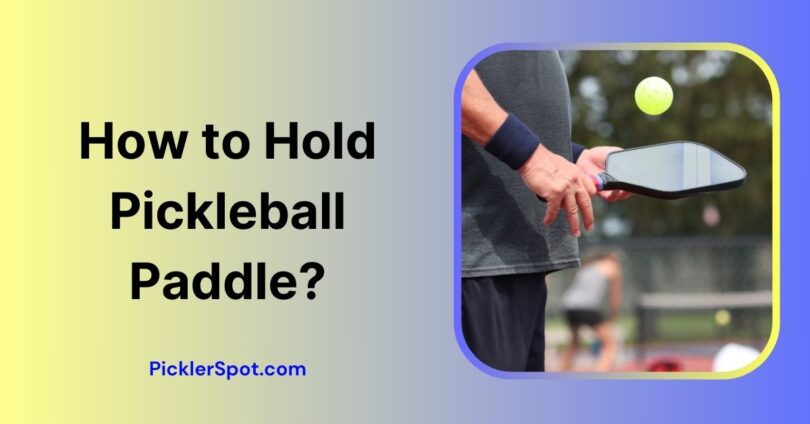Spectating a sport is an amazing way to learn esoteric techniques and methodologies that you aren’t going to attain otherwise, as it provides a wider perspective that is free from obstruction and bias.
Speaking of which, in the court, while enjoying a professional Pickleball, you may have seen or witnessed opponents using variations of hand gestures, especially during the serve phase which not only looks enticing but also seemingly provides them a competitive edge.
As Captivating as it may sound to replicate that, it’s pretty evident that you will be requiring finesse and hand-eye coordination, but fret not, in this article I will shed light on how to hold pickleball paddles and describe their potential advantage in the court.
Types Of Grips To Hold A Pickleball Paddle
In general, there are three standard grips, here is a wider insight on how you can replicate it.
Continental grip
The easiest of the bunch and basically an all-rounder as it allows you to flexibly switch positions on a whim, giving even a rookie player an edge on the court if utilized correctly.
To perform a continental grip, make sure you place your hand directly across the grip while lining your index finger directly to the side of the handle, almost similar to a handshake gesture or while holding a hammer while striking a nail, it is that simple!
Continental grip is by far one of the most commonly used grips in Pickleball because it is used for Forehand volleys, backhand volleys, overheads, and dink shots since it allows you to position without compromising your body language.
It also allows you to defend against shots that may put you in awkward spots as it gives your arm plenty of room to swing back and forth and even cover for low-angle shots without getting obstructed which is why it is a commonly used grip among Pickleball players.
Western Grip
In this grip, you need to keep your arm in a neutral position while ensuring the Paddle remains perpendicular to the ground. It’s the second most regularly used grip in Pickleball since it provides stability and strength so that a player can swing easily with force or perform spins effortlessly.
This grip resembles a swapping motion, and in order to perform this grip you need to hold the paddle in such a way that the palm of your hand remains flat to the face of the Paddle.
While this grip is used particularly to execute stronger backhand shots, you can reinforce this grip by using your non-dominant hand in order to execute more force, however, it may limit your stance-changing flexibility.
Nevertheless, once effectively used in the court, it is by far the second most powerful grip designed to cater to beginner players who have no prior experience.
Eastern Grip
Lastly, we have the eastern grip which you may have seen utilized mostly by professional players who want to execute stronger forehand shots, however, the downside here is that it may limit your ability to perform flexible backhand shots.
In order to utilize an eastern Grip, you need to place your palm right across the grip while tilting the face of the paddle almost perpendicular to the ground while ensuring your finger touches and lines up the back of the paddle.
In this position, you can attain tons of stability and control, regardless of how rigorously you swing your Paddle.
Why Knowing How To Pickleball Paddle is Crucial
One or another you are going to utilize a proper grip in a pickleball chosen out of these three mentioned above. The benefits of these grips are well worth the effort such as,
- It allows you to seamlessly switch positions and prevents the chances of illegal shot execution or faults.
- Without using a proper gripping style, you will always face issues relating to hand-eye coordination and your whole rhythm will feel out of place.
- Serving plays a pivotal role in Pickleball, in fact, you cannot proceed without knowing a serving technique, and without a proper serving technique, your team will suffer.
- It also places your hand in a neutral position, so you will always be in a stance that will ensure that you counter the ball effectively.
- You would also attain proper body language on the court, allowing you to prevent injuries such as carpal tunnel and tennis elbow.
- Using grips, specifically the eastern grip, allows a player to attain higher chances of hitting a critical splice and drop shot since your sweet spot would be more exposed.
Which Grip Is Perfect for the Volley Phase?
Using the semi-western grip is highly ideal, once you have mastered it, however, it requires you to hold the paddle at a 45-degree angle at all times. But the silver lining here is that you would be able to execute low-angle shots directed at the feet of your opponent, allowing you to attain an edge and even score a couple of points along the way.
However, all of these are easier said than done as without practice, you may become overwhelmed easily, so it’s better that you take one step at a time and use basic grips such as Continental grip especially if you are getting into Pickleball.
Conclusive Word of Advice
Mastering how you hold your Pickleball Paddle is one of the most crucial steps that you clearly don’t want to overlook especially if you are a rookie that is learning the ropes or a Professional who wants to hone their skills, since there is always room for improvement.
Your body Language matters the most and holding your Pickleball Paddle certainly translates to your dexterity and skill set, so make sure you pay close attention to the steps and techniques mentioned above in the guide on How To Hold A Pickleball Paddle.
Lastly, once you have learned a technique, make sure you master it by practicing thoroughly by participating in drills to iron out any errors otherwise it will be reinforced in your muscle memory which could hamper your learning ability.









